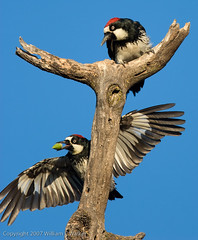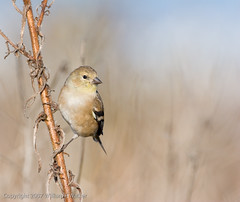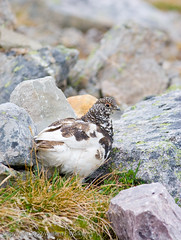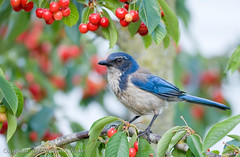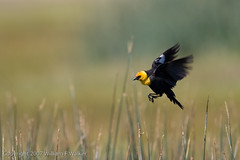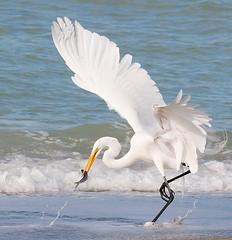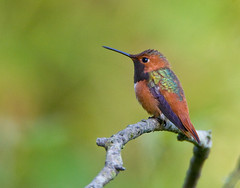Captiva Island, Florida [taken December 2006]
East-coast birders are very familiar with the Laughing Gull, but California birders like me find them fresh and intriguing. The black legs and black bill indicate that this bird is in non-breeding winter plumage. On the sandy beach of Captiva island, with the beautiful blue Gulf of Mexico in the background and puffy clouds overhead, this day sums up the best I can hope for myself and for you in 2008; many wonderful days spent outdoors in the presence of beautiful birds and gorgeous weather.
Friday, November 30, 2007
November, Acorn Woodpeckers
Guadelupe Oak Grove Park, San Jose, California [taken August 2007]
Acorn Woodpecker colonies gather and store acorns in granary trees. Each of the thousands of acorn they collect has to be fit into the proper-sized hole for the long winter. As the acorns dry, the woodpeckers move the shrinking acorns to smaller holes to keep them from falling out. Acorn Woodpeckers use a hard surface, such as the top of a tree limb or a wooden light post as an anvil to crack open the dry acorns and eat them at times when insects are not readily available. I love the clown-like facial coloring of the Acorn Woodpeckers, especially the round black patch surrounding the bill. In this photo, a male sits a the top of the tree while the female (identified by the black patch on the crown of her head) lands on the same tree, carrying an acorn in her bill.
Acorn Woodpecker colonies gather and store acorns in granary trees. Each of the thousands of acorn they collect has to be fit into the proper-sized hole for the long winter. As the acorns dry, the woodpeckers move the shrinking acorns to smaller holes to keep them from falling out. Acorn Woodpeckers use a hard surface, such as the top of a tree limb or a wooden light post as an anvil to crack open the dry acorns and eat them at times when insects are not readily available. I love the clown-like facial coloring of the Acorn Woodpeckers, especially the round black patch surrounding the bill. In this photo, a male sits a the top of the tree while the female (identified by the black patch on the crown of her head) lands on the same tree, carrying an acorn in her bill.
October, Spotted Towhee
Mount Umunum Road, Los Gatos, California [taken May 2007]
I drove the 35 windy miles to Mount Umunhum in Spring 2007 searching for a Black-chinned Sparrow. It was a lonely, foggy morning at the top of the mountain and I shot photos of several other birds while hunting for the sparrow. One special treat was seeing this Spotted Towhee at the top of a bush. "Spotties" are notorious skulkers, more often heard than seen, but it seemed the birds allowed me to approach more closely in the dense fog of this early morning. Singing is a full-body experience with this bird, and his manic, red eye increases the intensity of the moment.
I drove the 35 windy miles to Mount Umunhum in Spring 2007 searching for a Black-chinned Sparrow. It was a lonely, foggy morning at the top of the mountain and I shot photos of several other birds while hunting for the sparrow. One special treat was seeing this Spotted Towhee at the top of a bush. "Spotties" are notorious skulkers, more often heard than seen, but it seemed the birds allowed me to approach more closely in the dense fog of this early morning. Singing is a full-body experience with this bird, and his manic, red eye increases the intensity of the moment.
September, American Goldfinch
Half Moon Bay, California [taken October 2007]
American Goldfinches are a common subject for photographers and artists in their bright yellow summer plumage, but their subtle winter feathering is equally beautiful and a good sign of the changing seasons. A flock of goldfinches were feeding in thistles near the entrance to Venice Beach in Half Moon Bay. When the flock flew off, I set up my camera to wait for their return. The muted backdrop of dry grasses is another sign that we are entering fall and ready for the winter rains to come refresh the landscape.
American Goldfinches are a common subject for photographers and artists in their bright yellow summer plumage, but their subtle winter feathering is equally beautiful and a good sign of the changing seasons. A flock of goldfinches were feeding in thistles near the entrance to Venice Beach in Half Moon Bay. When the flock flew off, I set up my camera to wait for their return. The muted backdrop of dry grasses is another sign that we are entering fall and ready for the winter rains to come refresh the landscape.
August, Tufted Puffin
Pacific Ocean, off the coast of Bodega Bay [September 2007]
Tufted Puffins wear jaunty breeding plumage from April to September. At the time of this photo, the bird is shifting into winter plumage,when his entire head will be grey-black and his yellow cere (the skin where the bill meets the head ) will turn black to match the head. Our ocean-going birding trip in September out of Bodega Bay with Shearwater Journeys had amazingly calm seas and overcast skies, which allowed me to keep shooting all day. When we found this puffin on the water, the captain cut the engines and allowed us to drift close to the bird -- so close we could see the bird's feet under the surface of the ocean. The two furrows in the bird's upper mandible indicate that this bird is 3-4 years old and will reach sexual maturity in the next year or so.
Tufted Puffins wear jaunty breeding plumage from April to September. At the time of this photo, the bird is shifting into winter plumage,when his entire head will be grey-black and his yellow cere (the skin where the bill meets the head ) will turn black to match the head. Our ocean-going birding trip in September out of Bodega Bay with Shearwater Journeys had amazingly calm seas and overcast skies, which allowed me to keep shooting all day. When we found this puffin on the water, the captain cut the engines and allowed us to drift close to the bird -- so close we could see the bird's feet under the surface of the ocean. The two furrows in the bird's upper mandible indicate that this bird is 3-4 years old and will reach sexual maturity in the next year or so.
July, White-tailed Ptarmigan
Jasper National Park, Alberta, Canada [July 2007]
We traveled to Canada in summer 2007 with Paradise Birding, on a trip led by Steve Shunk and David Wimpfheimer. This was our only day above the treeline at Jasper National Park. We walked from the tramway terminus up a gently-sloping path around the mountain, where we found a female Ptarmigan with her brood. Higher up, at the very top of the mountain, we found 3 males in close proximity. As you can imagine, we were all very excited about this moment and tried contain our enthusiasm so as not to frighten the (nearly oblivious) birds. The ptarmigan males did not really respond to our presence -- they seemed more interested in posturing for each other, taking dustbaths and short naps. Their half-white, half-speckled summer plumage is perfect camouflage for their summer habitat among mossy rocks with splotches the same color as the bird. Photographing these birds was an intense emotional experience, made more intense by a mysterious problem with my camera. As the ptarmigan males ran towards me, my camera refused to take any shots, and I nearly threw it off the mountain! Afterwards, I spent a few quiet moments just observing the birds, freed of the need to make photographs and just able to enjoy them.
We traveled to Canada in summer 2007 with Paradise Birding, on a trip led by Steve Shunk and David Wimpfheimer. This was our only day above the treeline at Jasper National Park. We walked from the tramway terminus up a gently-sloping path around the mountain, where we found a female Ptarmigan with her brood. Higher up, at the very top of the mountain, we found 3 males in close proximity. As you can imagine, we were all very excited about this moment and tried contain our enthusiasm so as not to frighten the (nearly oblivious) birds. The ptarmigan males did not really respond to our presence -- they seemed more interested in posturing for each other, taking dustbaths and short naps. Their half-white, half-speckled summer plumage is perfect camouflage for their summer habitat among mossy rocks with splotches the same color as the bird. Photographing these birds was an intense emotional experience, made more intense by a mysterious problem with my camera. As the ptarmigan males ran towards me, my camera refused to take any shots, and I nearly threw it off the mountain! Afterwards, I spent a few quiet moments just observing the birds, freed of the need to make photographs and just able to enjoy them.
June, Western Scrub Jay
Hidden Villa, Los Altos, CA [June 2007]
As a member of the Bay Area Bird Photographers, I keep up with hot tips posted on our local email list. This cherry tree at Hidden Villa was mentioned on our list as providing both an abundant food source and a beautiful photographic backdrop for robins, jays and grosbeaks, who seemed to take turns at the tree, giving me a chance to photograph each one, like students lining up for yearbook pictures. The California scrub-jay is intensely blue and white, where the interior race is much more muted in color.
As a member of the Bay Area Bird Photographers, I keep up with hot tips posted on our local email list. This cherry tree at Hidden Villa was mentioned on our list as providing both an abundant food source and a beautiful photographic backdrop for robins, jays and grosbeaks, who seemed to take turns at the tree, giving me a chance to photograph each one, like students lining up for yearbook pictures. The California scrub-jay is intensely blue and white, where the interior race is much more muted in color.
May: Yellow-headed Blackbird in flight
Sierra Valley, CA [taken June 2007]
This is a moment captured from our first summer birding trip in the Sierra, led by the inestimable Bob Power. We parked at a bend in the road through a marshy/agricultural area and walked back towards the main concentration of reeds. Yellow-headed blackbirds were flying, perched, feeding, interacting all around us. Their calls are nasal, chirpy, and even buzzy like a log going through a sawmill, so different from the Red-winged blackbirds we hear in our local marshes. This shot shows a lot about the anatomy of a bird -- look at the way the breast muscles are activated when the wings are fully extended behind the bird, ready to provide air braking for the imminent landing in the reeds.
This is a moment captured from our first summer birding trip in the Sierra, led by the inestimable Bob Power. We parked at a bend in the road through a marshy/agricultural area and walked back towards the main concentration of reeds. Yellow-headed blackbirds were flying, perched, feeding, interacting all around us. Their calls are nasal, chirpy, and even buzzy like a log going through a sawmill, so different from the Red-winged blackbirds we hear in our local marshes. This shot shows a lot about the anatomy of a bird -- look at the way the breast muscles are activated when the wings are fully extended behind the bird, ready to provide air braking for the imminent landing in the reeds.
April, Great Egret
Captiva Island, Florida [taken December 2006]
Captiva is an exclusive beach community just beyond Sanibel Island. Formerly, it was an independent island, but it has largely become attached to Sanibel by a roadway and silt. We arrived about 10 am, after a visit to Ding Darling NWR. The public beach was lined with fishermen casting into the surf and the herons were sticking near the fishermen to grab any cast off bait or small-fry that might be tossed aside. Our photo group took advantage off the habits these birds have learned from close association with the fishermen -- tossing a few bait fish in the direction which gave the most pleasing background for the photo. Great Egrets are found in most coastal and southern states. They are stately and zen-like with their dramatically contrasting black legs, white plumage and yellow bills.
Captiva is an exclusive beach community just beyond Sanibel Island. Formerly, it was an independent island, but it has largely become attached to Sanibel by a roadway and silt. We arrived about 10 am, after a visit to Ding Darling NWR. The public beach was lined with fishermen casting into the surf and the herons were sticking near the fishermen to grab any cast off bait or small-fry that might be tossed aside. Our photo group took advantage off the habits these birds have learned from close association with the fishermen -- tossing a few bait fish in the direction which gave the most pleasing background for the photo. Great Egrets are found in most coastal and southern states. They are stately and zen-like with their dramatically contrasting black legs, white plumage and yellow bills.
March, Short-billed Dowitcher
Radio Road pond, Foster City, California [taken April 2007]
The pond at the very end of Radio Road is a great location for photography. it has great afternoon light and the photographer can creep right down to the water's edge. Getting down at eye level with the birds helps you see the world from their view point. Dowitchers spend most of their time in the water, "probing the ground with a sewing-machine like motion" so it was a real treat to see this bird fully out of the water. If you look closely, you can see partial webbing between the toes of both feet. The breeding colors and the bunchy posture give this bird a lot of personality. Identifying dowitcher species is tough, but in breeding plumage the spotting pattern on the breast and sides plus the extensive white on the underparts make this bird a Short-billed (Thanks to Al Jaramillo and Stephanie Ellis for help with this identification).
The pond at the very end of Radio Road is a great location for photography. it has great afternoon light and the photographer can creep right down to the water's edge. Getting down at eye level with the birds helps you see the world from their view point. Dowitchers spend most of their time in the water, "probing the ground with a sewing-machine like motion" so it was a real treat to see this bird fully out of the water. If you look closely, you can see partial webbing between the toes of both feet. The breeding colors and the bunchy posture give this bird a lot of personality. Identifying dowitcher species is tough, but in breeding plumage the spotting pattern on the breast and sides plus the extensive white on the underparts make this bird a Short-billed (Thanks to Al Jaramillo and Stephanie Ellis for help with this identification).
February: Allen's Hummingbird
Presidio of San Francisco, California [taken March 2007]
Photographing wildlife in the park areas of The Presidio is a bit surreal -- surrounded by the busy city of San Francisco, the open landscape of The Presidio provides small oases for migrating birds, like this Allen's hummingbird, drinking from a spring in the park. On the weekday morning when I shot this male Allen's, Ashok Khosla and I had the park pretty much to ourselves, except for the occasional dog walker passing the spring where the hummingbirds had stopped to drink. Distinguishing this "orange rumped" Allen's from a "green-backed" Rufous hummingbird relies on other photos in the series, where we can see that his outer tail feathers are narrow and pin-like.
Photographing wildlife in the park areas of The Presidio is a bit surreal -- surrounded by the busy city of San Francisco, the open landscape of The Presidio provides small oases for migrating birds, like this Allen's hummingbird, drinking from a spring in the park. On the weekday morning when I shot this male Allen's, Ashok Khosla and I had the park pretty much to ourselves, except for the occasional dog walker passing the spring where the hummingbirds had stopped to drink. Distinguishing this "orange rumped" Allen's from a "green-backed" Rufous hummingbird relies on other photos in the series, where we can see that his outer tail feathers are narrow and pin-like.
January, Burrowing Owl
suburban Cape Coral, Florida [taken December 2006]
This owl is in trouble in Florida just as he is in California -- Burrowing Owl habitat is highly sought-after for development and the owls are strongly faithful to specific burrow sites, so it is difficult to relocate them as their habitat is consumed. Although I think of this as a California bird, it can be found in Florida, Texas and other southern states. The eyes of the Florida birds I photographed were much brighter and more saturated than their west coast cousins. Reflected in this bird's you see the rooflines of the suburban houses and other structures surrounding the burrow. Fortunately, the white flowers in this abandoned field make a pleasant setting.
This owl is in trouble in Florida just as he is in California -- Burrowing Owl habitat is highly sought-after for development and the owls are strongly faithful to specific burrow sites, so it is difficult to relocate them as their habitat is consumed. Although I think of this as a California bird, it can be found in Florida, Texas and other southern states. The eyes of the Florida birds I photographed were much brighter and more saturated than their west coast cousins. Reflected in this bird's you see the rooflines of the suburban houses and other structures surrounding the burrow. Fortunately, the white flowers in this abandoned field make a pleasant setting.
Wednesday, November 07, 2007
Many Questions at Lake Merritt
Ashok and I had many questions at Lake Merritt this morning:
(1) The first and most pressing of which was, "Where is the Tufted Duck?" There had been email reports of Tufted Duck in the week leading up to our visit, but we were unable to locate any Tufted Ducks among what must have been 1,000 scaup on the lake.
(2) Whose feet are these? It's not a really hard quiz for those who have birded around here, especially if you peek at the tail feathers.
(3) What duck is this? I had a diagnosis in mind while I was shooting this ambiguous brown female duck, and the more I looked at it afterwards I realized it was an usual bird.
(1) The first and most pressing of which was, "Where is the Tufted Duck?" There had been email reports of Tufted Duck in the week leading up to our visit, but we were unable to locate any Tufted Ducks among what must have been 1,000 scaup on the lake.
(2) Whose feet are these? It's not a really hard quiz for those who have birded around here, especially if you peek at the tail feathers.
(3) What duck is this? I had a diagnosis in mind while I was shooting this ambiguous brown female duck, and the more I looked at it afterwards I realized it was an usual bird.
Subscribe to:
Posts (Atom)

